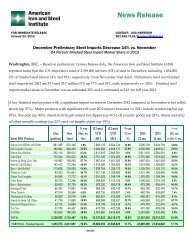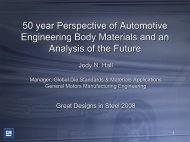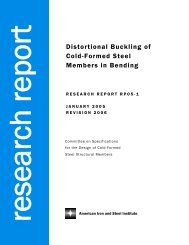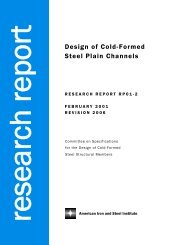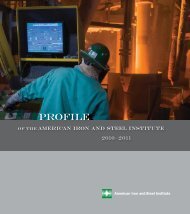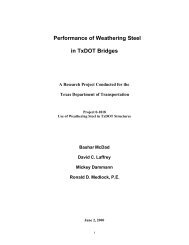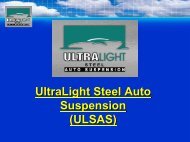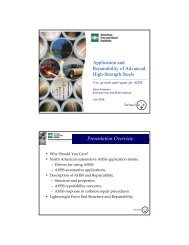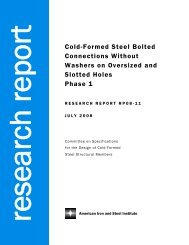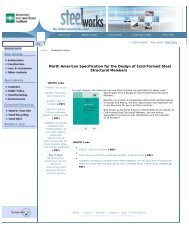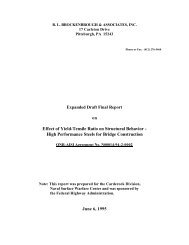Environmental Life Cycle Assessment of Southern Yellow Pine ...
Environmental Life Cycle Assessment of Southern Yellow Pine ...
Environmental Life Cycle Assessment of Southern Yellow Pine ...
You also want an ePaper? Increase the reach of your titles
YUMPU automatically turns print PDFs into web optimized ePapers that Google loves.
EXECUTIVE SUMMARY<br />
1 EXECUTIVE SUMMARY <br />
1.1 Introduction <br />
The American Iron and Steel Institute (AISI) estimates that approximately 185 million utility poles are <br />
in service in North America. 1 Wood poles comprise the majority <strong>of</strong> utility poles in the U.S. 2 However, <br />
some states and utilities have begun switching to steel poles, due to economical advantages over <br />
wood – for example, Nevada, Arizona in 1997, and Austin, Texas in the early 1990’s. 3,4 As different <br />
materials, steel and wood not only have different physical properties, but also different <br />
environmental impact pr<strong>of</strong>iles. <br />
The goal <strong>of</strong> this study is to use life cycle assessment (LCA) to compare the environmental <br />
performance <strong>of</strong> utility poles made from wood and galvanized steel. To achieve this goal, the study <br />
compares the use <strong>of</strong> utility poles in the Southeastern United States (US), made from each <strong>of</strong> these <br />
competing materials. Today, utility poles in this region are primarily wood made from <strong>Southern</strong> <br />
yellow pine, <strong>of</strong>ten treated with chromated copper arsenate (CCA); this study assesses the <br />
implications <strong>of</strong> replacing these wood poles with galvanized steel poles over time. <br />
This report provides a detailed documentation <strong>of</strong> a complex assessment. The intended audience <strong>of</strong> <br />
the Executive Summary is a knowledgeable member <strong>of</strong> the utility industry, while for the main body <strong>of</strong> <br />
the report, the intended audience is a knowledgeable LCA practitioner. <br />
The intended application <strong>of</strong> this study is the “consequential” life cycle assessment (LCA) comparing a <br />
system <strong>of</strong> wood utility poles, with a system <strong>of</strong> galvanized steel utility poles, in the Southeastern US. 5<br />
The study conforms to ISO-‐14044 and the LEO-‐SCS-‐002 Final Committee Draft Standard, 6 using <br />
advanced environmentally relevant indicators that provide a foundational basis for comparisons <br />
between the two systems. <br />
1 Utility Poles. American Iron & Steel Institute. [http://www.smdisteel.org/en/Construction/Utility%20Poles.aspx] Accessed <br />
3/28/13. <br />
2 Shaban, A.O. Power Pole Research. Cal Poly San Luis Obispo, Electrical Engineering. 1/14/02. <br />
3 Oliver, D., Arizona Public Service Co. APS Selects Steel. Transmission & Distribution World. 8/1/01. <br />
[http://tdworld.com/mag/power_aps_selects_steel/index.html] <br />
4 Padavick, J., Austin Energy. Austin Energy Embraces Steel. Transmission & Distribution World. 7/1/03. <br />
[http://tdworld.com/mag/power_austin_energy_embraces/index.html] <br />
5 Use <strong>of</strong> the term “consequential” LCA refers to a <strong>Life</strong> cycle assessment that addresses both the primary consequences (i.e., <br />
biophysical impacts, for better or worse) <strong>of</strong> an industrial system, as well as the secondary consequences that can occur <br />
when one system is substituted for another based on changes in production markets. <br />
6 Type III <strong>Life</strong>-‐<strong>Cycle</strong> Impact Pr<strong>of</strong>ile Declarations for Products, Services, and Systems, is being developed under the open <br />
American National Standards Institute (ANSI) Process, administrated by the Leonardo Academy. See <br />
http://www.leonardoacademy.org/services/standards/life-‐cycle.html <br />
April 2013 | ©SCS Global Services <br />
ES-‐ 1



